Tantanmen (担々麺) is a Japanese version of Chinese Sichuan Dan Dan Noodles. Chinese Dan Dan Noodles has a very small amount of soup, but the Japanese version, Tantanmen comes with a plenty of soup just like ramen.
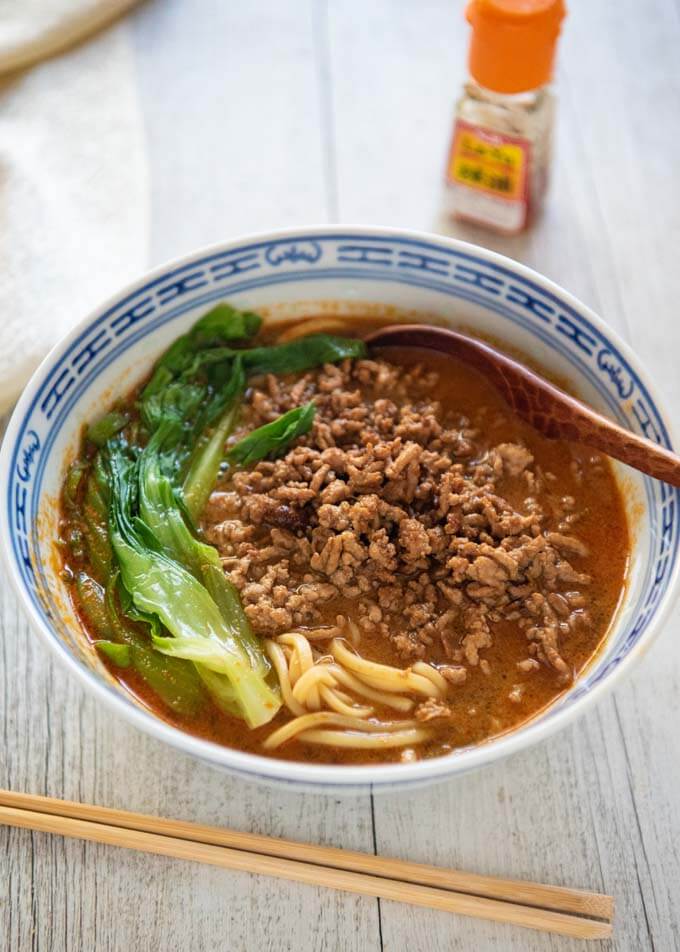
Like the original Dan Dan Noodles, Tantanmen is a spicy dish. The spice comes from the large amount of chilli oil added to the sesame-flavoured broth. The sweet miso-flavoured meat sauce topping is so tasty.
This topping is called ‘nikumiso’ (肉味噌) in Japanese, meaning meat miso. It is not spicy, and you wouldn’t call it Tantanmen without nikumiso. It also goes very well with cooked rice.
Japanese-style Dan Dan Noodles (Tantanmen) requires a few ingredients that you may not have in your pantry as standard items. But if you have all these ingredients, it is very easy to make a flavoursome, spicy noodle soup.
Tantanmen and the Iron Chef Chinese
It is said that the person who modified the Sichuan Dan Dan Noodles and invented Tantanmen in Japan is the chef called Chen Kenmin. He was born in Sichuan, China. After improving his culinary skills in China, he moved to Japan in 1952.
He originally specialised in Chinese Imperial cuisine, but when he opened his Shisen Hanten (四川飯店) restaurant in Japan, he started creating dishes that were better suited to the palate of his Japanese clientele. Tantanmen is one of such dishes.
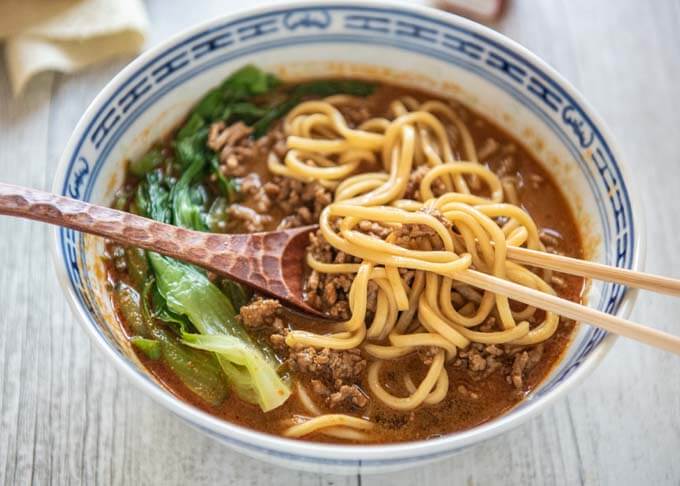
Do you remember the Japanese TV cooking show, Iron Chef (料理の鉄人, ‘ryōri no tetsujin’)? It was broadcast in the 1990s for 6 years in Japan. I watched every episode with my children when it was broadcast in Australia.
Chen Kenichi was the Iron Chef Chinese and Chen Kenmin, who invented Tantanmen, is his father.
When Chen Kenichi became known to the public through the Iron Chef TV show, he started appearing on TV in Japan, demonstrating how to cook his Chinese dishes. Today’s Tantanmen recipe is based on his recipe that was broadcast in 1996.
What’s in My Japanese-style Dan Dan Noodles (Tantanmen)
There are 3 key components in this recipe – noodles, spicy broth, and miso meat sauce.
Noodles
- Egg noodles – dried or fresh
The photo of noodles is in the Miso Meat Sauce (Nikumiso) section together with other ingredients.
Spicy Broth

From top right anticlockwise:
- Vinegar
- Finely chopped pickled mustard plant (榨菜, ‘zha cai’ or ‘cha tsai’ in Chinese)
- Rāyu (Japanese chilli oil)
- Sichuan pepper (optional)
- Soy sauce
- Sesame paste (芝麻醤, ‘zhīmajiàng‘ in Chinese, ‘chīmājan’ in Japanese)
- Finely chopped green onion
- Chinese chicken broth
Pickled mustard plant can be purchased at Japanese/Asian grocery stores. The Japanese version is called ‘zāsai’ and comes in a small jar (usually sliced).

Left: Zāsai (Japanese pickled mustard plant). Middle: A jar of zāsai. Right: Chinese pickled mustard plant in a pack.
You can buy a jar of sesame paste at Japanese/Asian grocery stores and in the Asian section of supermarkets (see the sample photos below). Although tahini is also a sesame paste, it lacks the nutty flavour because of the different method of making it. It would be best to buy a jar of Chinese sesame paste, 芝麻醤 or Carwari brand organic sesame paste. both of them have a distinct nutty flavour.
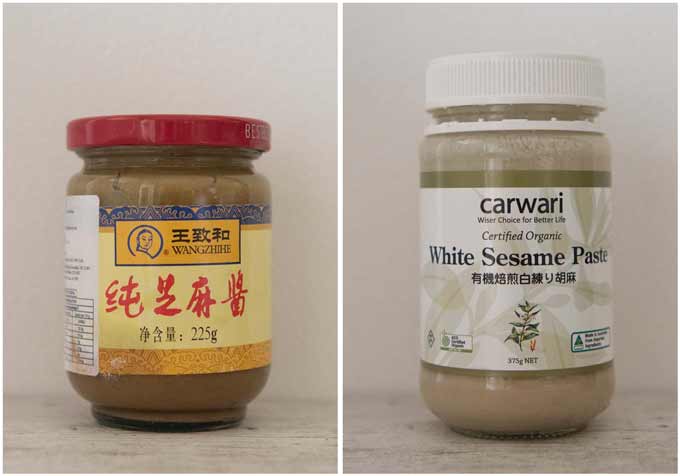
Left: Chinese sesame paste. Right: Carwari brand white sesame paste.
There are a couple of alternatives for Chinese Chicken Broth. Please see the subsequent section, ABOUT CHINESE CHICKEN BROTH.
Miso Meat Sauce (Nikumiso)
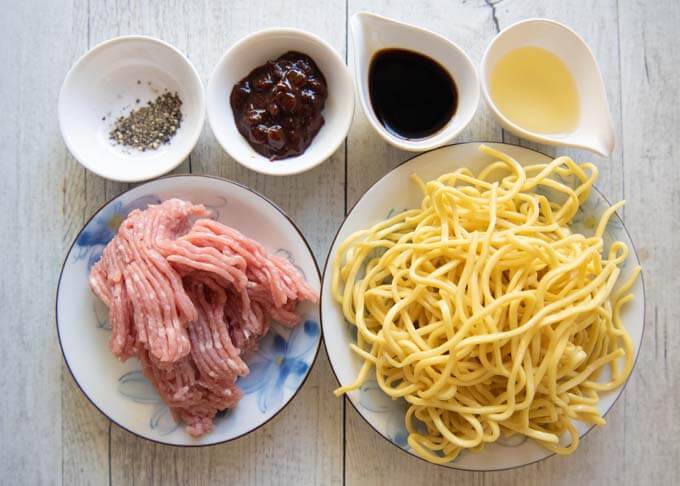
- Pork mince
- Oil
- Cooking sake
- Soy sauce
- Sweet soybean paste (甜麺醤, ‘tenmenjan’ in Japanese)
- Pepper
You can buy sweet soybean paste at a Chinese grocery stores and in the Asian section of supermarkets. Here is the photo of the sweet soybean paste that I used.
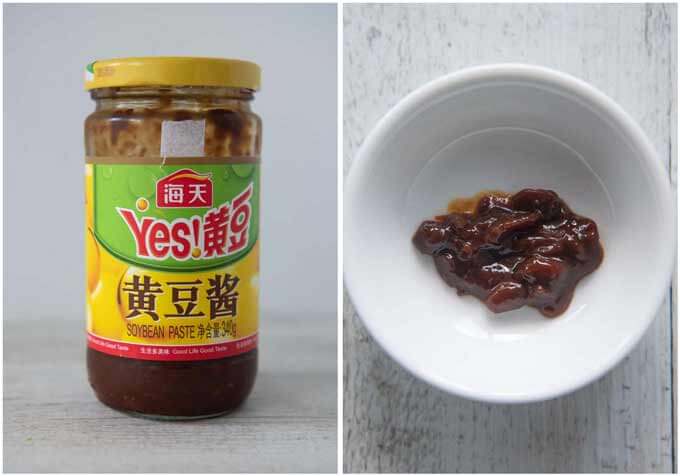
Garnish
- Blanched bok choy (not in photo)
About Chinese Chicken Broth
Chinese-style chicken stock is different from the Western-style chicken stock. Chinese-style stock is made only with ginger and green onions. The Western-style stock on the other hand is made with all kinds of vegetables, including celery and carrots, and that changes the flavour of the Spicy Broth of Tantanmen.
It is of course best to use a homemade chicken broth (you can use my recipe Easiest Chinese Chicken Broth!). But you can use a stock powder diluted in boiling water as an alternative.
I tried a Chinese chicken broth powder called ‘shantan‘ (シャンタン), which is made in Japan (left photo below), as well as the Lee Kum Kee brand powder that you can buy from supermarkets (right photo below). They both turned out great, but they are not as rich as the homemade broth.

How to Make Japanese-style Dan Dan Noodles (Tantanmen)
Just like the ingredient grouping, cooking also consists of 3 components, then they are assembled together. See the video.
- Put all the Spicy Broth ingredients, except the broth, into a serving bowl.
- Make Nikumiso.
- Cook noodles.
- Pour the broth into the bowl, then add the noodles.
- Put the Nikumiso on top, garnished with bok choy pieces.
Each step is quite simple, but the timing to complete each component is tricky.
Because you need to keep the broth hot, cook the toppings, and cook the noodles almost all at once, it will be easier if your cooktop has 3 burners. It also shortens the total time to make Tantanmen.
But if you don’t have 3 burners, you can put the cooked Nikumiso aside while cooking the noodles and keeping the broth hot. When the soup is added to the bowl, you can quickly heat up the Nikumiso.
Sichuan Dan Dan Noodles is Nagi’s favourite noodle dish. I was certain that she would enjoy my Tantanmen too.
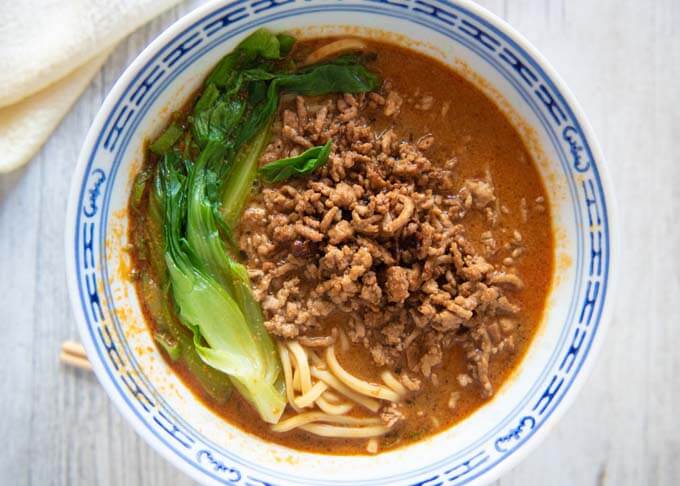
After making Tantanmen as a test run, I took a photo of the dish and shared it with my children, adding a note: ‘It was so delicious!’. Even if Nagi was extremely busy at work, she quickly responded to say ‘YUM! OMG mum that looks like my kind of food, please can you make it for me?? Please!!’. I knew it!
Yumiko![]()
Watch How To Make It
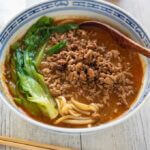
Tantanmen (担々麺) is a Japanese version of Chinese Sichuan Dan Dan Noodles. Unlike Sichuan Dan Dan Noodles, Tantanmen comes with plenty of spicy soup. The topping, i.e., sweet miso-flavoured meat sauce is so tasty. (see the video)
The recipe is based on Iron Chef Chinese, Chen Kenichi’s recipe that was broadcast in the late 1900s.
Prep Time and Cook Time do not include the time required to make chicken broth.
Don't forget to see the section 'MEAL IDEAS' below the recipe card! It gives you a list of dishes that I have already posted and this recipe that can make up a complete meal. I hope it is of help to you.
- 150g/5.3oz fresh egg noodles (or 1 serving dried noodles, note 1)
- 1 tsp pickled mustard plant (榨菜, note 2) finely chopped
- ½ tsp vinegar
- 2 tbsp soy sauce
- 2 tbsp sesame paste (芝麻醤, note 3)
- 2 tbsp rāyu (chilli sesame oil, note 4)
- 2 tbsp green onion finely chopped
- A large pinch of Sichuan pepper (optional)
- 350ml/11.8fl.oz Chinese chicken broth (note 5)
- 150g/5.3oz pork mince
- 1 tbsp oil
- 1 tbsp cooking sake
- 1 tbsp soy sauce
- 1 tbsp sweet soybean paste (甜麺醤, note 6)
- 2 pinches pepper
- 1 stem bok choy vertically quartered and blanched
-
Put all the Spicy Broth ingredients, excluding chicken broth, into a serving bowl.
-
Mix well, ensuring that there are no lumps of the sesame paste (note 7).
-
Add oil to a wok or frying pan over high heat.
-
Add pork mince to the wok/pan and sauté, breaking mince up as much as possible.
-
When the mince has changed to light brown in colour and is almost cooked through, add the rest of the Miso Meat Sauce (Nikumiso) ingredients to the wok/pan.
-
Mix well and continue to cook until the liquid has almost evaporated. Turn the heat off (note 8).
-
Bring a sufficient amount of water in a saucepan to a boil and cook egg noodles as per the instructions on the package of the noodles. Drain the noodles well (note 8).
-
Bring the chicken broth to a boil (note 8).
-
Add the broth to the serving bowl. Mix lightly.
-
Transfer the noodles to the bowl.
-
Put the Nikumiso on top and bok choy pieces on the side.
-
Serve immediately.
1. You can use either dried noodles or fresh noodles. Any medium to thin egg noodles suited for noodle soup are fine. Follow the instructions on the package of the noodles to cook them.
Do not use hokkien noodles as they are oily and suited for stir-frying.
2. It is called ‘zha cai’ or ‘cha tsai’ in Chinese and ‘zāsai’ in Japanese. It has a crunchy texture and a distinct salty flavour. See the photo in the post.
Instead of zāsai, you can use Sichuan preserved mustard greens called ‘sui mi ya cai’ (碎米芽菜) that you can buy at Asian grocery stores. Please refer to Nagi's post, Dan Dan Noodles which explains about sui mi ya cai with a photo.
3. It is a Chinese version of sesame paste. It is called ‘chīmājan’ in Japanese. I also used Carwari brand white sesame paste, which is slightly different from the Chinese version, and it worked well.
Compared to Carwari brand, chīmājan had a stronger roasted sesame flavour and the colour was browner.
Although tahini is also a sesame paste, it lacks a nutty flavour because of the different method of making it. If possible, try to get a Chinese sesame paste as it has the strongest nutty sesame flavour.
4. You can use chilli oil instead. The difference is that rāyu is often made with sesame oil, while chilli oil uses normal oil such as canola oil.
5. It is best to use homemade chicken broth. But as an alternative quick solution, you can use store-bought chicken powder diluted in boiling water.
I tried a Chinese chicken broth powder called 'shantan' (シャンタン), which is made in Japan, as well as Lee Kum Kee brand powder that you can buy from supermarkets (see the photo in the post). Although the powder-based broth was not as rich as the homemade chicken broth, both worked great.
Dilute 2 teaspoons of chicken broth powder in 350ml/11.8fl.oz of boiling water.
The Western-style chicken stock does not suit this dish because it contains other vegetables such as celery and carrots, which change the flavour of the spicy broth.
6. It is called ‘tenmenjan’ in Japanese, but it is a Chinese ingredient commonly used in Northern Chinese cuisine. You can buy sweet soybean paste at Asian grocery stores as well as supermarkets. See the photo in the post.
7. When the jar of your sesame paste is left on the shelf for a long time, the clear oil splits from the sesame powder, leaving the powder at the bottom of the jar. You need to mix them well before measuring the sesame paste to make a dish. But the sesame powder is so dense that it is extremely hard to mix it into the oil and you may end up with a few lumps of sesame paste in your bowl.
8. Ideally, Miso Meat Sauce (Nikumiso), egg noodles, and Chicken broth should be hot and ready at the same time. If you have three cooktop burners, this is achievable by timing each component right.
If you have two burners, you can make Nikumiso first, then heat it up when one burner becomes available. It doesn’t take long to heat it up.
If you are using powdered broth, you don’t need three burners. Boil water in a kettle to make a broth.
Noodles should be added to the bowl as soon as they are cooked. Leaving them for a while after being cooked make the noodles soggy and bloated.
Meal Ideas
A typical Japanese meal consists of a main dish, a couple of side dishes, a soup and rice. I try to come up with a combination of dishes with a variety of flavours, colours, textures and make-ahead dishes.
Because today’s dish is a noodle dish, I can omit rice from the meal idea. Instead, I need to add more vegetables to the meal.
Sunomono is a perfect salad to go with a rich and spicy noodle dish. It cleanses the palate. I think Sesame Bean Sprouts is also a perfect match for Tantanmen. Some Tantanmen recipes even add bean sprouts in the topping.
If you feel that the amount of protein in the Tantanmen is not sufficient, you can add a light protein dish such as Hiyayakko or Tamagotoji.
- Main: Japanese-style Dan Dan Noodles (Tantanmen) – today’s recipe.
- Side dish 1: Sesame Bean Sprouts – make ahead.
- Side dish 2: Cucumber and Seaweed Sunomono (Vinegar Dressing) – or other fresh salad with light dressing.
- Protein boost: Chilled Tofu (Hiyayakko) 4 Ways or Japanese Style Scrambled Eggs (Tamago Toji).

This dish is delish. I was inspired to find a recipe for Tan Tan Ramen after swooning over a bowl full in New Zealand recently. Your recipe is spot on in replicating the tastiness and flavour that I’ve been dreaming about since. Thanks for putting together such a clear recipe with great tips for sourcing the correct ingredients.
Hi Liza, that’s fantastic! Now you don’t need to visit the ramen shop in NZ!
I may seem ignorant, but I have to ask: so many online recipes call for soy milk with this soup. What is your take on that??
Hi Tatjana, I have not encountered a dan dan noodles recipe with milk added to the soup. I wonder if it is confused with Laksa, which is meant to use coconut milk, but some recipes use milk as an alternative. Laks is also spicy. Or perhaps the recipes with milk attempts to make the spiciness milder.
This is my favorite dish at my local izakaya place- Kizuki. Thank you for the recipe! It’s yummy and very close in taste.
Hi Erin, thanks for your feedback. I am very pleased to know that it was very close to the dish at Kizuki!